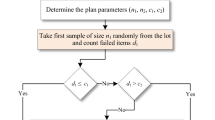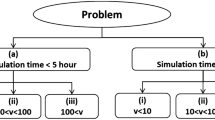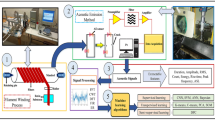Abstract
Failure-probability-based global sensitivity (FP-GS) analysis can measure the effect of the input uncertainty on the failure probability. The state-of-the-art for estimating the FP-GS are less efficient for the rare failure event and the implicit performance function case. Thus, an adaptive Kriging nested Importance Sampling (AK-IS) method is proposed in this work to efficiently estimate the FP-GS. For eliminating the dimensionality dependence in the calculation, an equivalent form of the FP-GS transformed by the Bayes’ formula is employed by the proposed method. Then the AK model is nested into IS for recognizing the failure samples. After all the failure samples are correctly identified from the IS sample pool, the failure samples are transformed into those subjected to the original conditional probability density function (PDF) on the failure domain by the Metropolis–Hastings algorithm, on which the conditional PDF of the input on the failure domain can be estimated for the FP-GS finally. The proposed method highly improves the efficiency of estimating the FP-GS comparing with the state-of-the-art, which is illustrated by the results of several examples in this paper.











Similar content being viewed by others
References
Wu XJ, Zhang WW, Song SF, Ye ZY (2018) Sparse grid-based polynomial chaos expansion for aerodynamics of an airfoil with uncertainties. Chin J Aeronaut 31(5):997–1011
Roger M, Jan CM, Noortwijk V (1999) Local probabilistic sensitivity measures for comparing FORM and Monte Carlo calculations illustrated with dike ring reliability calculations. Comput Phys Commun 117(1):86–98
Song SF, Lu ZZ, Qiao HW (2009) Subset simulation for structural reliability sensitivity analysis. Reliab Eng Syst Saf 94(2):658–665
Zhao YG, Ono T (2001) Moment methods for structural reliability. Struct Saf 23(1):47–75
Zhao YG, Ono T (2004) On the problems of the Fourth moment method. Struct Saf 26(3):343–347
Xu L, Cheng GD (2003) Discussion on: moment methods for structural reliability. Struct Saf 25(2):193–199
Song K, Zhang Y, Zhuang X et al (2019) Reliability-based design optimization using adaptive surrogate model and importance sampling-based modified SORA method. Eng Comput 37(2):1295–1314
Abdollahi A, Azhdary Moghaddam M, Hashemi Monfared SA et al (2020) Subset simulation method including fitness-based seed selection for reliability analysis. Eng Comput. https://doi.org/10.1007/s00366-020-00961-9
Song SF, Lu ZZ, Zhang WW, Ye ZY (2009) Reliability and sensitivity analysis of transonic flutter using improved line sampling technique. Chin J Aeronaut 22(5):513–519
Rocha LCS, Rotela Junior P, Aquila G et al (2020) Toward a robust optimal point selection: a multiple-criteria decision-making process applied to multi-objective optimization using response surface methodology. Eng Comput. https://doi.org/10.1007/s00366-020-00973-5
Yang I, Hsieh Y (2013) Reliability-based design optimization with cooperation between support vector machine and particle swarm optimization. Eng Comput 29:151–163
Gordan B, Koopialipoor M, Clementking A et al (2019) Estimating and optimizing safety factors of retaining wall through neural network and bee colony techniques. Eng Comput 35:945–954
Zhai Z, Li H, Wang X (2020) An adaptive sampling method for Kriging surrogate model with multiple outputs. Eng Comput. https://doi.org/10.1007/s00366-020-01145-1
Cui LJ, Lu ZZ, Zhao XP (2010) Moment-independent importance measure of basic random variable and its probability density evolution solution. Sci China Technol Sci 53(4):1138–1145
Li LY, Lu ZZ, Feng J, Wang BT (2012) Moment-independent importance measure of basic variable and its state dependent parameter solution. Struct Saf 38:40–47
Wei PF, Lu ZZ, Hao WR, Feng J, Wang BT (2012) Efficient sampling methods for global reliability sensitivity analysis. Comput Phys Commun 183(8):1728–1743
Yun WY, Lu ZZ, Jiang X (2019) An efficient method for moment-independent global sensitivity analysis by dimensional reduction technique and principle of maximum entropy. Reliab Eng Syst Saf 187:174–182
Zhang XF, Pandey MD (2013) Structural reliability analysis based on the concepts of entropy, fractional moment and dimensional reduction method. Struct Saf 43:28–40
Wang YP, Xiao SN, Lu ZZ (2019) An efficient method based on Bayes’ theorem to estimate the failure-probability-based sensitivity measure. Mech Syst Signal Process 115:607–620
Wang YP, Xiao SN, Lu ZZ (2018) A new efficient simulation method based on Bayes’ theorem and importance sampling Markov chain simulation to estimate the failure-probability-based global sensitivity measure. Aerosp Sci Technol 79:364–372
Yun WY, Lu ZZ, Zhang Y, Jiang X (2018) An efficient global reliability sensitivity analysis algorithm based on classification of model output and subset simulation. Struct Saf 74:49–57
Xiao SN, Lu ZZ (2017) Structural reliability sensitivity analysis based on classification of model output. Aerosp Sci Technol 71:52–61
Zellner A (2007) Generalizing the standard product rule of probability theory and Bayes’s Theorem. J Econom 138(1):14–23
Echard B, Gayton N, Lemaire M (2011) AK-MCS: an active learning reliability method combining Kriging and Monte Carlo simulation. Struct Saf 33(2):145–154
Echard B, Gayton N, Lemaire M, Relun N (2013) A combined Importance Sampling and Kriging reliability method for small failure probabilities with time-demanding numerical models. Reliab Eng Syst Saf 111:232–240
Cadini F, Santos F, Zio E (2014) An improved adaptive kriging-based importance technique for sampling multiple failure regions of low probability. Reliab Eng Syst Saf 131:109–117
Dubourg V, Sudret B, Deheeger F (2013) Metamodel-based importance sampling for structural reliability analysis. Probab Eng Mech 33:47–57
Huang XX, Chen JQ, Zhu HP (2016) Assessing small failure probabilities by AK–SS: an active learning method combining Kriging and Subset Simulation. Struct Saf 59:86–95
Depina I, Le TMH, Fenton G, Eiksund G (2016) Reliability analysis with Metamodel line sampling. Struct Saf 60:1–15
Engelund S, Rackwitz R (1993) A benchmark study on importance sampling techniques in structural reliability. Struct Saf 12(4):255–276
Alibrandi U, Der Kiureghian A (2012) A gradient-free method for determining the design point in nonlinear stochastic dynamic analysis. Probab Eng Mech 28:2–10
Ibrahim Y (1991) Observations on applications of importance sampling in structural reliability analysis. Struct Saf 9(4):269–281
Hastings WK (1970) Monte Carlo sampling methods using Markov chains and their applications. Biometrika 57(1):97–109
Rosenblatt M (1956) Remarks on some nonparametric estimates of a density function. Ann Math Stat 27(3):832–837
Parzen E (1962) On estimation of a probability density function and mode. Ann Math Statist 33(3):1065–1076
Cacoullos T (1966) Estimation of a multivariate density. Ann Math Stat 18(2):179–189
Botev ZI, Grotowski JF, Kroese DP (2010) Kernel density estimation via diffusion. Ann Statist 38(5):2916–2957
Au SK (2004) Probabilistic failure analysis by importance sampling Markov Chain simulation. J Eng Mech 130(3):303–311
Johnson AA, Jones GL, Neath RC (2013) Component-Wise Markov Chain Monte Carlo: uniform and geometric ergodicity under mixing and composition. Stat Sci 28(3):360–375
Rackwitz R, Flessler B (1978) Structural reliability under combined random load sequences. Comput Struct 9(5):489–494
Wang P, Lu ZZ, Tang ZC (2013) A derivative based sensitivity measure of failure probability in the presence of epistemic and aleatory uncertainties. Comput Math Appl 65:89–101
Lv ZY, Lu ZZ, Wang P (2015) A new learning function for Kriging and its applications to solve reliability problems in engineering. Comput Math Appl 70(5):1182–1197
Acknowledgements
This work was supported by the National Natural Science Foundation of China (Grants 51775439).
Author information
Authors and Affiliations
Corresponding author
Appendices
Appendix A: The variation coefficient of the estimates
The variation coefficient of \(\hat{P}\left\{ F \right\}\) is estimated by the following equation:
The variation coefficient of \(\hat{P}\left\{ {F\left| {x_{ji} } \right.} \right\}\) is estimated by the following equation:
It is difficult to derive the variation coefficient of \(\hat{\xi }_{i}\) and no derivation process about the variation coefficient of \(\hat{\xi }_{i}\) has been found in the existing literature. Generally, the variation coefficient of \(\hat{\xi }_{i}\) can be obtained by repeated calculation process. Assumed that \(\hat{\xi }_{i}\) is calculated for \(N_{C}\) times by \(N_{1}\) samples, which are randomly generated for each time. The variation coefficient of \(\hat{\xi }_{i}\) can be obtained by the following equation:
where \(\hat{\xi }_{i}^{\left( q \right)}\) is the estimated value of \(\hat{\xi }_{i}\) calculated for the \(q\)-th time, and \(q = 1,2, \ldots ,N_{C}\).
Appendix B: Determination for \(N\) , \(N_{1}\) , \(N_{2}\) and \(M\)
Taking \(N\) as example, to meet the requirement for the variation coefficients of \(\hat{P}\left\{ F \right\}\), the number \(N\) is determined by the following process:
-
(1)
Generate \(N\) random samples of the inputs and construct the sample pool \({\mathbf{S}}^{f}\), \(N{ = }10000\) is advised at the first time to execute step (1);
-
(2)
Estimate the failure probability;
-
(3)
Calculate the variation coefficient of \(\hat{P}\left\{ F \right\}\), i.e., \(COV\left( {\hat{P}\left\{ F \right\}} \right)\), if \(COV\left( {\hat{P}\left\{ F \right\}} \right) < 5\%\), turn to step (5), else turn to step (4);
-
(4)
Set \(N{ = }N + 5000\) and turn to step (1);
-
(5)
Record the results of \(\hat{P}\left\{ F \right\}\), \(COV\left( {\hat{P}\left\{ F \right\}} \right)\).
The processes for determining \(N_{1}\), \(N_{2}\) and \(M\) are similar to that for \(N\) and no longer illustrated here.
Rights and permissions
About this article
Cite this article
Lei, J., Lu, Z. & Wang, L. An efficient method by nesting adaptive Kriging into Importance Sampling for failure-probability-based global sensitivity analysis. Engineering with Computers 38, 3595–3610 (2022). https://doi.org/10.1007/s00366-021-01402-x
Received:
Accepted:
Published:
Issue Date:
DOI: https://doi.org/10.1007/s00366-021-01402-x




